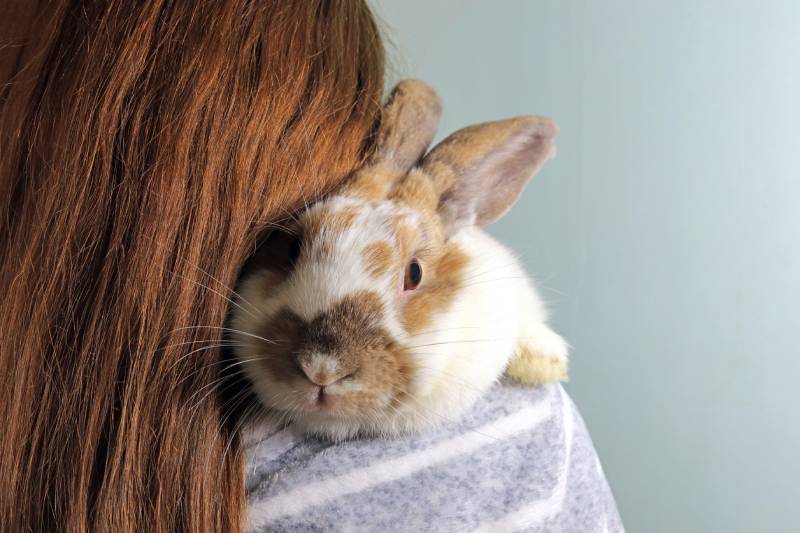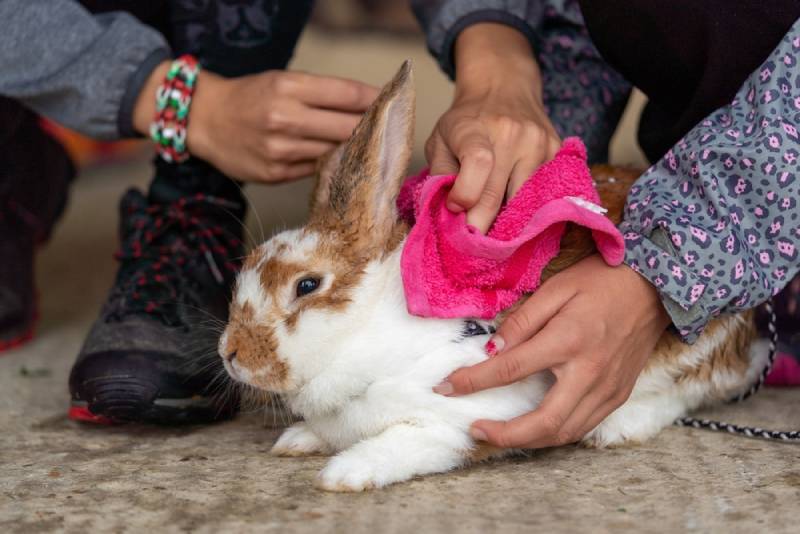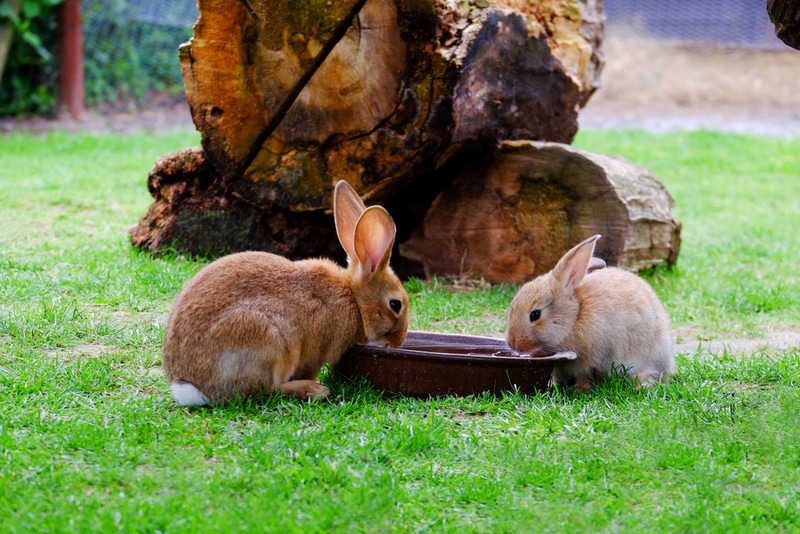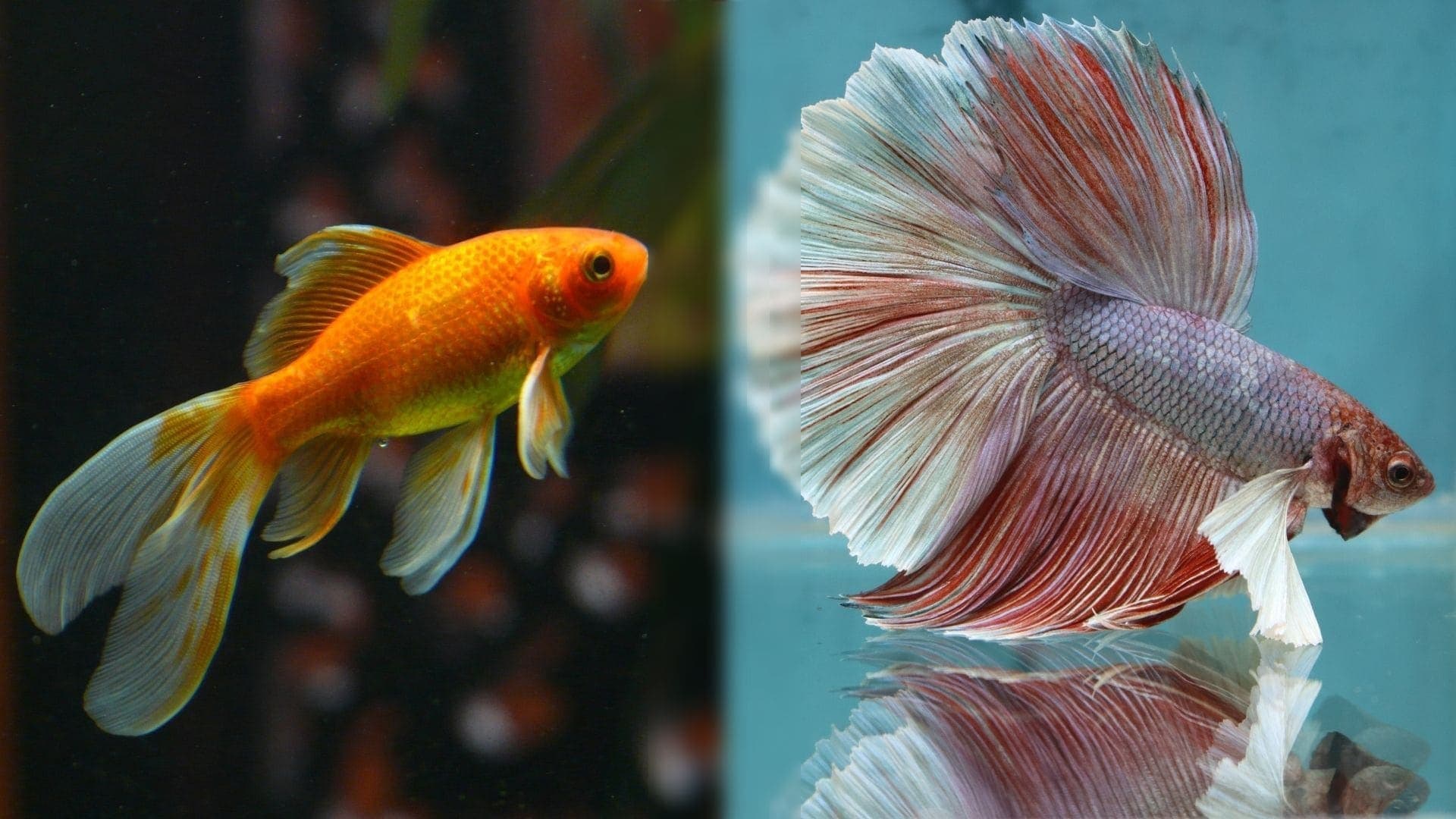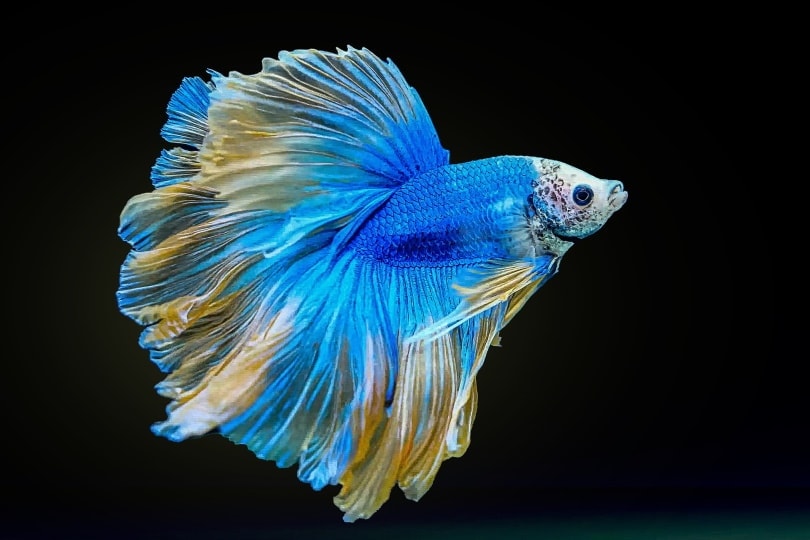14 Rabbit Sleeping Positions & Their Meanings (With Pictures)

Updated on
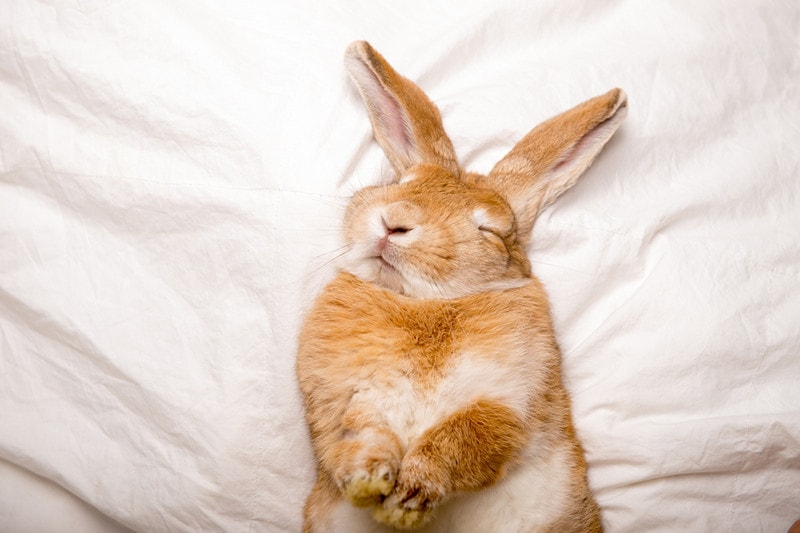
Click to Skip Ahead
Rabbits are cute already, but they’re even cuter when they sleep. But rabbits have a variety of sleeping positions that aren’t just cute! They can also provide insight into your rabbit’s physical and emotional well-being. Here are the most common rabbit sleeping positions and their meanings.
The 14 Rabbit Sleeping Positions
1. The Loaf
In this position, the rabbit tucks its legs under its body and sits upright with a rounded back, resembling a loaf of bread. Its head is held up, and its eyes may be closed or half-closed. This indicates that the rabbit is comfortable and relaxed while still being alert to its surroundings.
- Normal sleeping position: Yes
- Monitor for distress? No
- Indicates relaxation and alertness
- Common among rabbits in familiar environments

2. The Flop
The rabbit suddenly lies on its side with its legs stretched out and head resting on the ground, often after a dramatic roll or flop. This position indicates that the rabbit is very relaxed and feels safe in its environment. It may even twitch or snore softly while sleeping in this position.
- Normal sleeping position: Yes
- Monitor for distress? No
- Signifies a high level of comfort and security
- May be accompanied by soft snoring or twitching
3. The Sprawl
The rabbit lies on its stomach with its legs stretched out behind or to the side. Its head may be resting on the ground or slightly elevated. This position helps the rabbit cool down when feeling warm and suggests relaxation. It may also indicate that the rabbit is enjoying some sunbathing or simply stretching out after a nap.
- Normal sleeping position: Yes
- Monitor for distress? No
- Adopted during warmer temperatures or after exercise
- Can be a sign of a well-adjusted rabbit
4. The Side-Sleep
The rabbit lies on its side with its legs slightly bent and sometimes resting one front paw on the other. Its head may be resting on the ground or elevated on a paw or toy. This position indicates that the rabbit is comfortable and feels secure in its environment, allowing it to fully relax its muscles.
- Normal sleeping position: Yes
- Monitor for distress? No
- Demonstrates trust in the environment
- Common in rabbits that feel at ease with their surroundings
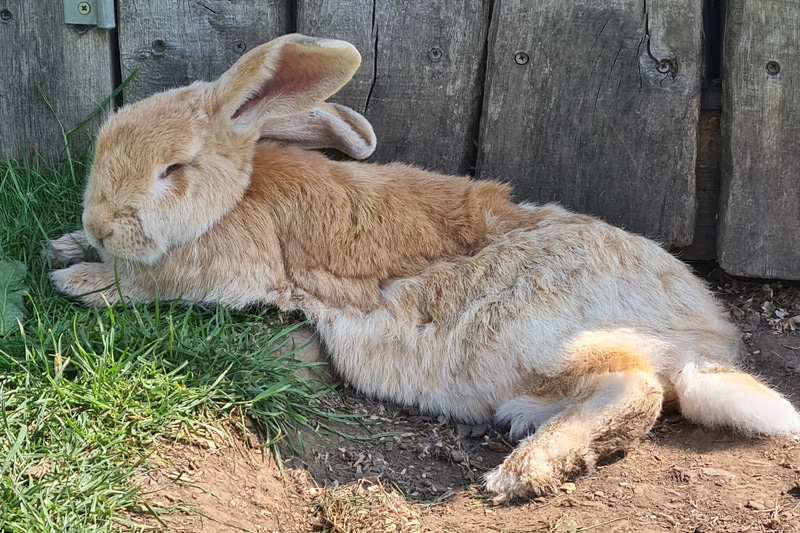
5. The Bunny Ball
The rabbit curls up into a tight ball, tucking its head and limbs close to its body. Its ears may be flat against its back or wrapped around its body for additional warmth. This position helps the rabbit conserve heat and suggests that it may be feeling cold or seeking comfort and security.
- Normal sleeping position: Yes
- Monitor for distress? No
- Sign of seeking warmth and comfort
- Common during colder temperatures or drafts
6. The Half-Flop
The rabbit lies on its side with its front legs tucked under its body and its hind legs stretched out, creating an appearance of partial relaxation. Its head may be resting on the ground or slightly elevated. This position can be a transition between the loaf and the flop positions, indicating a state of partial relaxation and comfort.
- Normal sleeping position: Yes
- Monitor for distress? No
- Demonstrates a moderate level of comfort
- Can be a transition between the loaf and the flop positions
7. The Superman
The rabbit lies on its stomach with its front and hind legs stretched out in opposite directions, resembling a superhero in flight. Its head may be resting on the ground or slightly elevated. This position is often adopted when the rabbit wants to stretch its muscles or cool down after playtime or exercise, as it exposes more of the rabbit’s body to air.
- Normal sleeping position: Yes
- Monitor for distress? No
- Suggests a desire for muscle relaxation or cooling
- May occur after playtime or exercise

8. The Nose Dive
The rabbit lies on its stomach with its front legs tucked under its body and its nose touching the ground. Its ears may be flat against its back or held up slightly. This position suggests that the rabbit is resting but still alert to its surroundings, as it can quickly raise its head to observe any potential threats.
- Normal sleeping position: No
- Monitor for distress? No
- Indicates a state of rest while maintaining vigilance
- Common among rabbits in new or unfamiliar environments
9. The Semi-Sprawl
The rabbit lies on its side with its front legs stretched out and its hind legs slightly bent, creating a relaxed version of the sprawl position. Its head may be resting on the ground or slightly elevated. This position is another variation of the sprawl, indicating relaxation and comfort during periods of rest or napping.
- Normal sleeping position: Yes
- Monitor for distress? No
- Signifies a relaxed state similar to the sprawl
- May be adopted during periods of rest or napping
10. The Cuddle
The rabbit snuggles up against another rabbit or a soft object, such as a stuffed toy or blanket. Its head may be resting on the other rabbit or object, and its body may be curled up or stretched out. This position demonstrates a desire for warmth and companionship, as the rabbit seeks physical contact for comfort.
- Normal sleeping position: Yes
- Monitor for distress? No
- Indicates a need for warmth or social interaction
- May occur when rabbits are bonding or seeking comfort
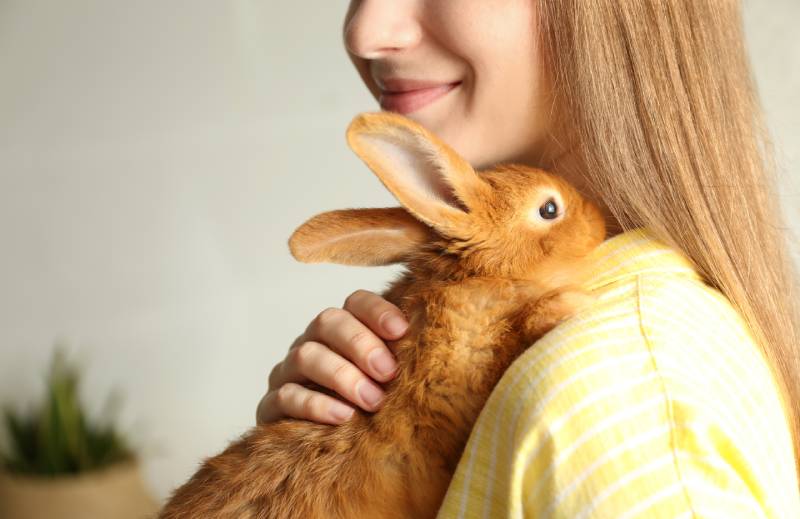
11. The Reverse Loaf
The rabbit sits with its back legs tucked under its body and its front legs extended, creating an appearance similar to the loaf but with reversed leg positions. Its head is held up, and its eyes may be closed or half-closed. This position is less common than the loaf and indicates a more relaxed state while still being alert.
- Normal sleeping position: No
- Monitor for distress? No
- Suggests a comfortable resting position
- Can be a sign of relaxation in a secure environment
12. The Swaying Sleep
The rabbit stands on its hind legs, swaying gently while dozing off, with its front legs resting on a ledge or another elevated surface. This position is rare and may indicate that the rabbit is feeling insecure or uneasy about lying down, as it allows the rabbit to quickly escape if necessary.
- Normal sleeping position: No
- Monitor for distress? Yes
- May signify insecurity or anxiety
- Requires observation to ensure the rabbit’s well-being
13. The Chin Rest
The rabbit lies on its stomach with its head resting on an elevated surface, such as a ledge or another rabbit. Its front legs may be tucked under its body or stretched out beside it. This position allows the rabbit to keep an eye on its surroundings while resting, maintaining a level of alertness even during sleep.
- Normal sleeping position: No
- Monitor for distress? No
- Indicates a desire to stay alert while resting
- Common among rabbits in new environments or with dominant personalities
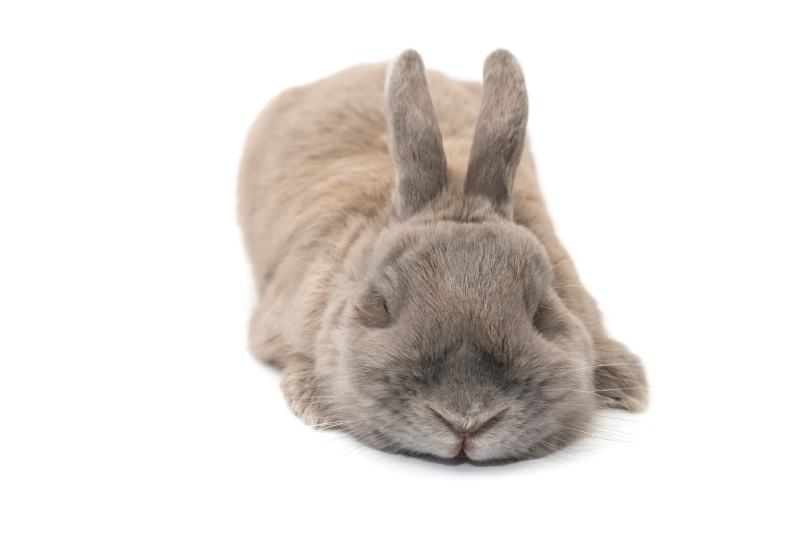
14. The Tummy Curl
The rabbit lies on its back with its legs curled up towards its belly, exposing its vulnerable underside. Its head may be tilted to the side or resting on the ground. This position is rare and indicates a high level of trust and comfort, as it requires the rabbit to feel extremely safe in its environment to assume such a vulnerable position.
- Normal sleeping position: No
- Monitor for distress? No
- Demonstrates a strong bond and trust with the environment or owner
- Only occurs when the rabbit feels extremely safe
The 5 Tips to Keep Your Rabbit Safe While They Sleep
To ensure your rabbit’s safety and comfort while they sleep, it is essential to create a secure and cozy environment. Here are some key considerations for providing a safe sleeping space:
1. Designated Sleeping Area
Provide a designated area within your rabbit’s enclosure or living space where they can sleep undisturbed. This area should be quiet, dimly lit, and away from any high-traffic areas in your home.
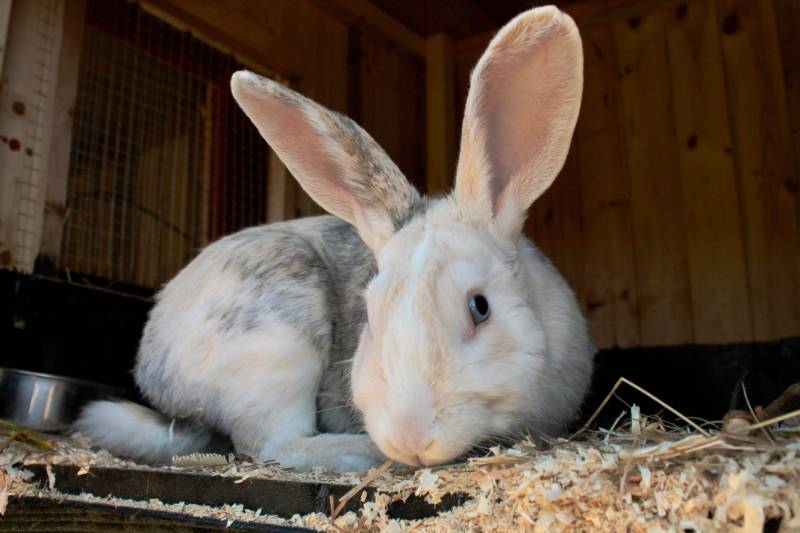
2. Soft Bedding
Offer soft bedding materials, such as hay, fleece blankets, or a specialized rabbit bed. This will provide cushioning and support for your rabbit while they sleep, preventing discomfort or pressure sores.
3. Hiding Spots
Rabbits feel safer when they have hiding spots available to them. Provide hideouts, such as cardboard boxes, tunnels, or commercial hidey houses, where your rabbit can retreat to if they feel threatened or need a quiet place to rest.
4. Temperature Control
Ensure that the room temperature is comfortable for your rabbit, typically between 60–70°F (15–21°C). Avoid placing their sleeping area near drafts, direct sunlight, or heat sources, as extreme temperatures can cause distress or illness.
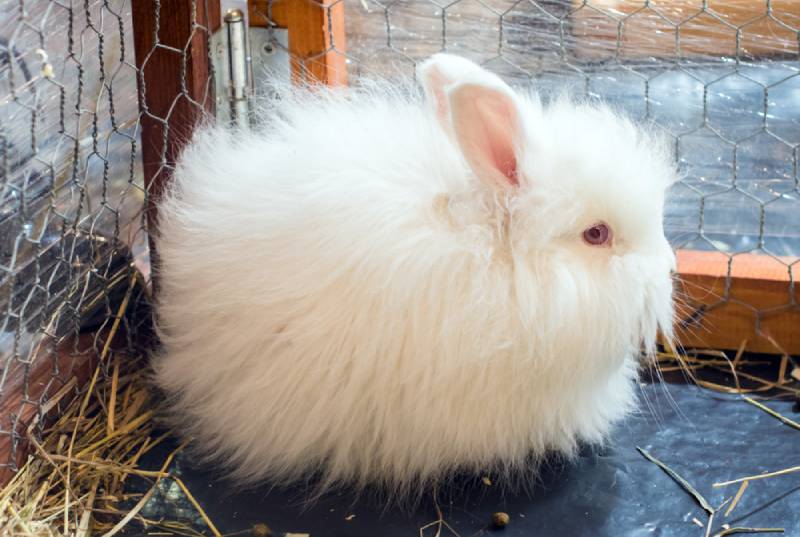
5. Cleanliness
Regularly clean your rabbit’s sleeping area to maintain hygiene and prevent the buildup of bacteria or fungi. Replace soiled bedding, sanitize surfaces, and ensure proper ventilation to keep the environment fresh and healthy.
Recognizing Signs of Distress
While rabbits may occasionally adopt unusual sleeping positions, it is essential to monitor their behavior and look for signs of distress or health issues.
- Restlessness: If your rabbit is unable to settle down or constantly changes sleeping positions, this could indicate discomfort, stress, or an underlying health issue.
- Vocalizations: While some rabbits may make soft noises while they sleep, excessive vocalizations or unusual sounds could signal distress or pain.
- Changes in Sleeping Patterns: Sudden changes in your rabbit’s sleeping patterns, such as sleeping more or less than usual, may indicate stress or a potential health problem.
- Refusal to Sleep in Designated Area: If your rabbit suddenly refuses to sleep in their designated area, this could suggest that something is causing them distress or discomfort in that location.
- Lethargy or Weakness: If your rabbit appears lethargic or weak when they wake up from sleep, this could be a sign of an underlying health issue or poor sleep quality.
- Labored Breathing or Panting: Labored breathing or panting during sleep can indicate respiratory distress, overheating, or other health concerns.
If you notice any of these signs of distress in your rabbit, it is essential to consult your veterinarian to address any potential underlying issues and ensure your rabbit’s well-being.
Conclusion
Understanding rabbit sleeping positions and behaviors can provide valuable insights into your pet’s overall well-being and comfort. By familiarizing yourself with these positions, you can better monitor your rabbit’s health, identify potential issues, and create a comfortable environment for them to rest and sleep.
Featured Image Credit: Sharomka, Shutterstock


